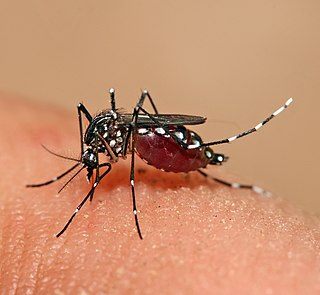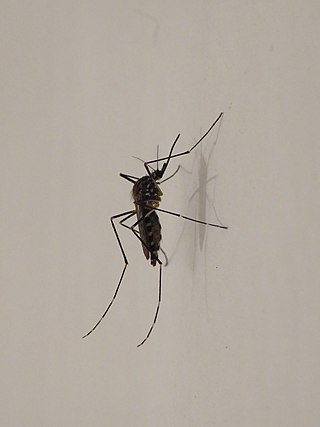
Aedes albopictus, from the mosquito (Culicidae) family, also known as the (Asian) tiger mosquito or forest mosquito, is a mosquito native to the tropical and subtropical areas of Southeast Asia. In the past few centuries, however, this species has spread to many countries through the transport of goods and international travel. It is characterized by the white bands on its legs and body.

Aedes is a genus of mosquitoes originally found in tropical and subtropical zones, but now found on all continents except perhaps Antarctica. Some species have been spread by human activity: Aedes albopictus, a particularly invasive species, was spread to the New World, including the United States, in the 1980s, by the used-tire trade.

Aedes aegypti, the yellow fever mosquito, is a mosquito that can spread dengue fever, chikungunya, Zika fever, Mayaro and yellow fever viruses, and other disease agents. The mosquito can be recognized by black and white markings on its legs and a marking in the form of a lyre on the upper surface of its thorax. This mosquito originated in Africa, but is now found in tropical, subtropical and temperate regions throughout the world.

Aedes vexans, the inland floodwater mosquito or tomguito, is a cosmopolitan and common pest mosquito. This species has been collected in southern California.

The 2007 Yap Islands Zika virus outbreak represented the first time Zika virus had been detected outside Africa and Asia. It occurred in the Yap Islands, an island chain in the Federated States of Micronesia. Zika virus (ZIKV) is a vector-borne flavivirus in the same family as yellow fever, dengue, West Nile and Japanese encephalitis viruses.
Aedes africanus is a species of mosquito that is found on the continent of Africa with the exclusion of Madagascar. Aedes aegypti and Aedes africanus are the two main yellow fever vector species in Zambia. Aedes africanus is mainly found in tropical forests not near wetlands.
Spondweni virus is an arbovirus, or arthropod-borne virus, which is a member of the family Flaviviridae and the genus Flavivirus. It is part of the Spondweni serogroup which consists of the Sponweni virus and the Zika virus (ZIKV). The Spondweni virus was first isolated in Nigeria in 1952, and ever since, SPONV transmission and activity have been reported throughout Africa. Its primary vector of transmission is the sylvatic mosquito Aedes circumluteolus, though it has been isolated from several different types of mosquito. Transmission of the virus into humans can lead to a viral infection known as Spondweni fever, with symptoms ranging from headache and nausea to myalgia and arthralgia. However, SPONV is phylogenetically close to the ZIKV, it is commonly misdiagnosed as ZIKV along with other viral illnesses.
Aedes hensilli is a mosquito species originally collected in 1945 on Ulithi atoll in the Caroline Islands of the western Pacific Ocean, about 191 km east of Yap State. It is the most abundant and widespread Aedes (Stegomyia) species mosquito in Yap State, the only Aedes (Stegomyia) species on Woleai, and the only species of mosquito present on Eauripik.
Aedes apicoargenteus is an African mosquito species, first described as Stegomyia apicoargentea from specimens collected in Ashanti, Ghana.
Aedes vittatus is a species of mosquito that was first described in 1861 as Culex vittatus from specimens collected on Corsica. In 2000, the species was transferred to the newly erected subgenus Fredwardsius as the type species representing the subgenus.
Aedes furcifer was named in 1913 as a nomen novum for nigra (Theobald). Aedes furcifer and Aedes taylori have been treated as two species, usually found sympatrically, but are difficult to separate morphologically so the term "Aedes furcifer-taylori group" has been used for the two species, and they have not always been differentiated by workers conducting studies on them.
Aedes hoogstraali is a species of mosquito. It was first described from specimens collected at Subic Bay, Republic of the Philippines in 1945. The specific epithet honors noted entomologist and acarologist Harry Hoogstraal.
Aedes malayensis was first described in 1963 by Australian entomologist Donald Henry Colless as a subspecies of Aedes scutellaris from males collected at Pulau Hantu, Keppel Harbor, Singapore. In 1972 the subspecies was elevated to species status by Yiau-Min Huang, although the move was disputed by the original describer on biological as opposed to morphological principles.
Aedes bahamensis, also known as Howardina bahamensis, is a mosquito native to the Caribbean and Bahamas, which was first discovered in two counties of southern Florida in 1986,. The females of the species do not require a blood meal to produce eggs, although they will bite if starved of nectar or in order to produce a second brood. They are thought to be capable of transmitting St. Louis encephalitis.
Aedes cordellieri is a sub-Saharan African species of mosquito suspected of being a vector of yellow fever. The species name honors Dr. Roger Cordellier, a former medical entomologist with Office de la Recherche Scientifique et Technique Outre-Mer (ORSTOM) in Ivory Coast, in recognition of his contributions to the knowledge of the mosquito fauna of Africa.
Culex perfuscus is the only Culex species mosquito currently implicated as a possible vector of Zika virus. The species type was described in 1914 from Port Herald, Nyasaland by entomologist Frederick Wallace Edwards.
Aedes mediovittatus, the "Caribbean treehole mosquito," was first described in 1906 as Stegomyia mediovittata by Daniel W. Coquillett.

Aedes koreicus is a mosquito species originally described from Korea that has been shown to be enzootic to Japan, northeastern China, the Republic of Korea, parts of Russia, but recently found in Belgium, Italy, Germany, Hungary, Slovenia, Switzerland and Kazakhstan. Adult Aedes koreicus are relatively large, with areas of white scales on black background, strongly resembling Aedes japonicus, which has also become established outside its native range.

Aedes japonicus, commonly known as the Asian bush mosquito or the Asian rock pool mosquito, was first described by Theobald in 1901 from Tokyo, Japan and has four known subspecies Ae. j. japonicus, Ae. j. shintienensis, Ae. j. yaeyamensis, and Ae. j. amamiensus. They are competent arbovirus vectors known to transmit the West Nile virus as well as Japanese and St. Louis encephalitis. They are listed as an invasive species by the Global Invasive Species Database.






